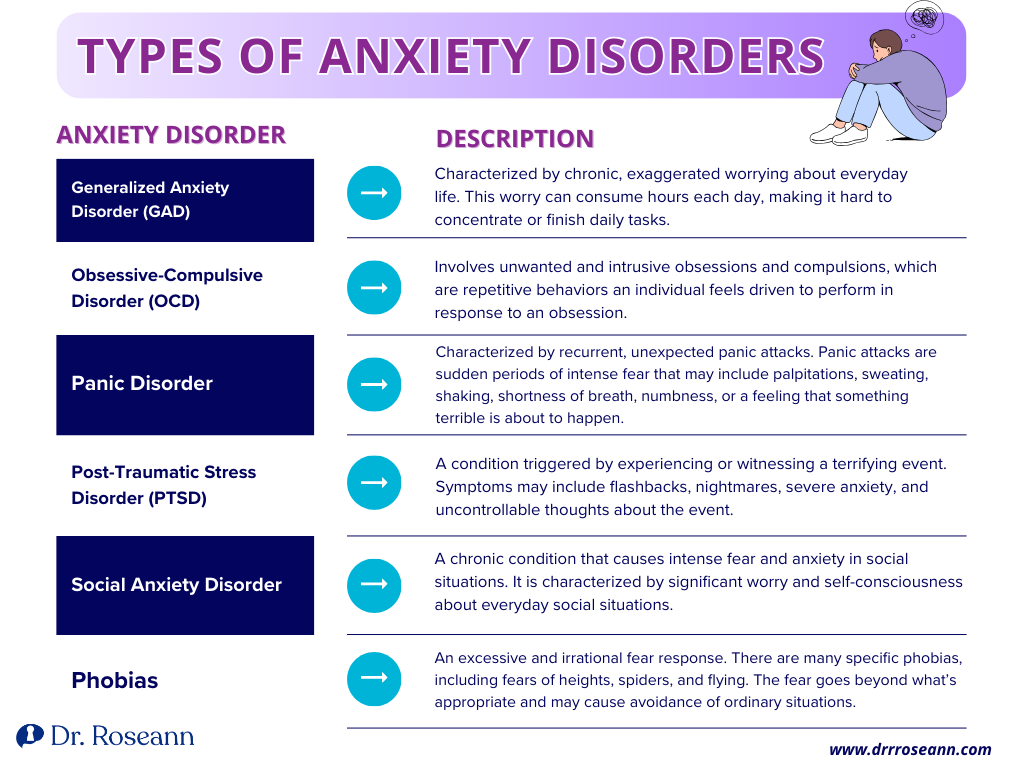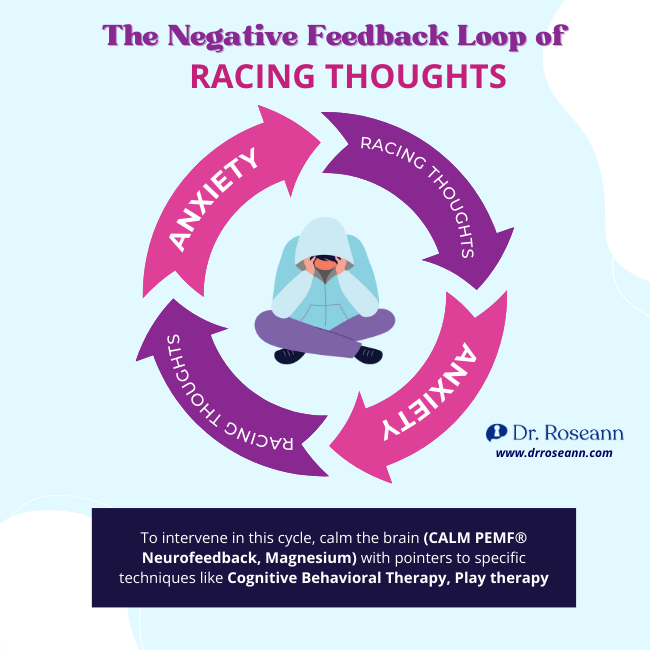Living with anxiety can be challenging, and for those dealing with anxiety disorders, the constant barrage of anxious thoughts can make daily life feel overwhelming. Managing anxiety is crucial for both mental and physical well-being.
I’ve written hundreds of articles on anxiety and talked about it in many media interviews. Working with children and teens suffering from anxiety for decades allowed me to develop innovative therapeutic techniques accessible through the BrainBehaviorResetTM Program to help parents manage their kid’s stress and build resilience.
Anxiety Disorders and its Complexity
Anxiety disorders are multifaceted conditions that affect millions of people worldwide. Characterized by excessive worry, fear, and nervousness, these disorders can manifest in various forms, such as generalized anxiety disorder (GAD), panic disorder, obsessive-compulsive disorder (OCD), and post-traumatic stress disorder (PTSD). Anxiety often stems from a combination of genetic, environmental, and neurological factors, making it a complex condition to unravel.
Research suggests a correlation between childhood trauma and the development of anxiety disorders later in life (Huh et al., 2014). Understanding the root causes can be pivotal in devising effective strategies to manage anxiety. It is essential to recognize that anxiety is not a one-size-fits-all condition, and each individual's experience may differ significantly.

Racing Thoughts and the Negative Feedback Loop
One of the hallmark symptoms of anxiety is the experience of racing thoughts, where the mind seems to spiral uncontrollably from one worry to another. This incessant mental chatter creates a negative feedback loop, reinforcing and amplifying anxious feelings. The mind becomes trapped in a cycle of negative thinking, perpetuating heightened stress levels and exacerbating anxiety symptoms.
To address racing thoughts, it's crucial to intervene in the cognitive processes that contribute to this loop. Cognitive Behavioral Therapy (CBT) is a widely recognized and effective approach to breaking this cycle. Identifying and challenging negative thought patterns allows individuals to reframe their perspectives and gain better control over their anxious thoughts.

The Cycle of Anxiety
Intense anxiety has a profound impact on daily life, often leading to a cycle of challenging experiences. Bad days, marked by a heightened anxiety level and overwhelming negative emotions, can pave the way for sleepless nights. The lack of sleep, in turn, intensifies feelings of anxiety, creating a vicious cycle that can be challenging to break.
Chronic anxiety not only creates even more mental health conditions but also manifests in physical symptoms such as increased heart rate, panic attacks, muscle tension, and even immune system suppression. This interplay between mental and physical health underlines the importance of addressing anxiety comprehensively.
Incorporating relaxation techniques, deep breathing exercises, and mindfulness practices can be instrumental in disrupting the cycle and promoting a more balanced emotional and physical state.
The Antidote to Chronic Worriers
For individuals grappling with chronic worries, here are tips that can emerge as a potent antidote. Anxiety often thrives on thoughts about the future or dwelling on past events, creating a perpetual state of worry. Cultivating awareness of the present moment and redirecting attention away from hypothetical scenarios and worst-case scenarios is the first step to breaking away from this condition.
1. Practice deep breathing techniques
Deep breathing stands out as a simple yet powerful technique to alleviate the physical and mental manifestations of anxiety. When anxiety strikes, the body enters a heightened state of arousal, marked by increased heart rate and shallow breathing. Deep breathing, also known as diaphragmatic or belly breathing, counters this physiological response by engaging the diaphragm and promoting a more profound inhalation and exhalation.
Taking deep breaths triggers the body's relaxation response, activating the parasympathetic nervous system. As a result, deep breathing helps reduce the production of stress hormones, lowers blood pressure, and calms the racing mind.
Incorporating deep breathing exercises into daily routines provides individuals with a readily accessible tool to manage anxiety in various stressful situations to moments of heightened emotional intensity.
2. Connect with your body to push down uncomfortable worry
Mindfulness, a practice rooted in ancient traditions like meditation and yoga, encourages individuals to immerse themselves fully in the present. By focusing on sensations, breathing, and the immediate surroundings, individuals can interrupt the stream of anxious thoughts. This deliberate redirection of attention helps break the cycle of chronic worrying, fostering a sense of control and tranquility.
Research suggests that mindfulness-based interventions and meditation practice can significantly reduce anxiety symptoms by altering brain activity associated with chronic stress and emotional regulation (Goldin & Gross, 2010). Integrating mindfulness into daily life, through practices like meditation or mindful breathing, empowers individuals to navigate challenges with a calmer and more centered mindset.
3. Flip your script and swap negative thoughts with a positive mantra
Swapping anxious thoughts with positive affirmations or mantras is a cognitive-behavioral technique grounded in principles of cognitive restructuring, attentional focus, self-fulfilling prophecy, neuroplasticity, and emotional regulation.
By consciously replacing negative thought patterns with positive affirmations or mantras, individuals actively restructure their thinking, redirect their attention away from sources of anxiety, and instill beliefs that promote resilience and optimism.
This process strengthens neural pathways associated with positive thinking while weakening those linked to anxious thoughts, leading to lasting changes in thought patterns and emotional responses. Moreover, positive affirmations and mantras serve as anchors for regulating emotions, helping individuals maintain a sense of calm and control amidst challenging circumstances.
Swapping anxious thoughts with positive affirmations or mantras is a practical and effective strategy for managing anxiety and fostering psychological well-being. It empowers individuals to challenge negative thought patterns, cultivate optimism, and regulate their emotions, ultimately promoting resilience and adaptive coping mechanisms.
How to stop thinking about something?
To stop thinking about something, actively redirect your focus onto a different task or engaging activity, effectively shifting your attention away from the persistent thoughts. Additionally, practicing mindfulness techniques, such as deep breathing or meditation, can help create distance from unwanted thoughts and promote a calmer state of mind.
What is progressive muscle relaxation?
Progressive muscle relaxation (PMR) is a relaxation technique involving the systematic tensing and then relaxing of different muscle groups in the body. This method is the best way to alternate muscle tension with relaxation. PMR helps reduce overall muscle tension, alleviate stress, and promote a state of physical and mental relaxation.
How can blue light help alleviate anxiety?
Blue light exposure, particularly from sources like natural sunlight or artificial light emitted by electronic devices, can influence mood and anxiety levels through its effects on the body's circadian rhythm and production of neurotransmitters like serotonin.
Can a warm bath address chronic pain and promote better sleep?
Yes, a warm bath can help address chronic pain by relaxing muscles, improving blood circulation, and reducing inflammation, which can provide temporary relief from discomfort. Additionally, taking a warm bath before bedtime can promote better sleep by lowering stress levels, inducing relaxation, and helping to regulate body temperature, all of which contribute to a more restful night's sleep.
What does the body feel when doing physical activity?
When engaging in physical activity, the body feels stimulated. It releases endorphins and neurotransmitters that act as natural painkillers and mood elevators, resulting in feelings of euphoria and reduced anxiety. Additionally, physical activity is a great way to promote relaxation. It helps reduce muscle tension and provide a healthy outlet for pent-up energy, helping to alleviate symptoms of anxiety and promote a sense of well-being.
Dr. Roseann is a Children’s Mental Health Expert and Licensed Therapist who has been featured in/on hundreds of media outlets including The Mel Robbins Show, CBS, NBC, PIX11 NYC, Today, FORBES, CNN, The New York Times, The Washington Post, Business Insider, Women’s Day, Healthline, CNET, Parade Magazine and PARENTS. FORBES called her, “A thought leader in children’s mental health.”

She coined the terms, “Re-entry panic syndrome” and “eco-anxiety” and is a frequent contributor to media on mental health.
Dr. Roseann Capanna-Hodge has three decades of experience in working with children, teens and their families with attention-deficit hyperactivity disorder (ADHD), autism, concussion, dyslexia and learning disability, anxiety, Obsessive Compulsive Disorder (OCD), depression and mood disorder, Lyme Disease, and PANS/PANDAS using science-backed natural mental health solutions such as supplements, magnesium, nutrition, QEEG Brain maps, neurofeedback, PEMF, psychotherapy and other non-medication approaches.
She is the author of three bestselling books, It’s Gonna Be OK!: Proven Ways to Improve Your Child's Mental Health, The Teletherapy Toolkit, and Brain Under Attack. Dr. Roseann is known for offering a message of hope through science-endorsed methods that promote a calm brain.
Her trademarked BrainBehaviorResetⓇ Program and It’s Gonna be OK!Ⓡ Podcast has been a cornerstone for thousands of parents facing mental health, behavioral or neurodevelopmental challenges.
She is the founder and director of The Global Institute of Children’s Mental Health, Neurotastic™Brain Formulas and Dr. Roseann Capanna-Hodge, LLC. Dr. Roseann is a Board Certified Neurofeedback (BCN) Practitioner, a Board Member of the Northeast Region Biofeedback Society (NRBS), Certified Integrative Mental Health Professional (CIMHP) and an Amen Clinic Certified Brain Health Coach. She is also a member of The International Lyme Disease and Associated Disease Society (ILADS), The American Psychological Association (APA), Anxiety and Depression Association of America (ADAA) National Association of School Psychologists (NASP), International OCD Foundation (IOCDF).
© Roseann-Capanna-Hodge, LLC 2024










